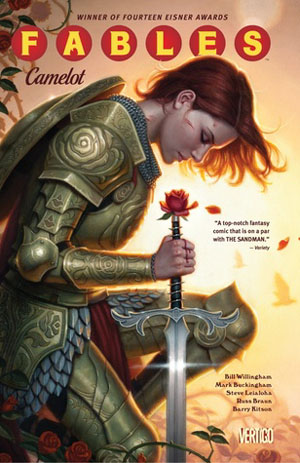 Fables: Camelot is number 20 in the collected trade paperbacks of Bill Willingham’s very popular series. It seems that Rose Red is going to revive King Arthur’s Round Table, with herself in the role of Arthur. And she’s going to vet the knights before they’re awarded a place at the table.
Fables: Camelot is number 20 in the collected trade paperbacks of Bill Willingham’s very popular series. It seems that Rose Red is going to revive King Arthur’s Round Table, with herself in the role of Arthur. And she’s going to vet the knights before they’re awarded a place at the table.
This is all against the fall-out from the previous series of adventures, in which Bigby Wolf has — at least in theory — been killed by Prince Brandish, who insists that he is Snow White’s rightful husband, even though they were never formally married, only betrothed. Snow White offers some payback: she stabs Brandish in the heart. (As it happens, Bigby was turned into a glass statue of a wolf and shattered; do remember that there’s a whole bunch of witches and other magic workers in residence in Fabletown.)
But first, there’s a little story about Rodney and June, formerly wooden puppets created by Gepetto and sent, as flesh-and-blood people, to spy on the Fables in Exile (they switched sides) and their daughter, Junebug, who are moving into the castle that has taken the place of the ruined castle. I should say that it’s part of a story: Junebug goes exploring, and makes a really exciting discovery, but her parents dismiss it as childish fantasy. And that’s it. Sorry to leave you hanging, but that’s what the story did.
I can’t say that there’s a lot of interest in this collection: there is the main story of Rose’s re-creation of the Round Table, and the secondary story of the attempts put Bigby back together, and the other secondary story of Snow White trying to keep her family together, now that they are, most of them, indeed together, and a minor plot line involving the theoretically perished Brandish, and the requisite plots, secrets, surprise appearances and re-appearances, and behind the scenes maneuvers. It doesn’t resolve itself into a particularly coherent narrative.
And it’s somehow flat. It’s quite possibly me, but it seems at this point that the characters are just going through the motions; the dialogue has lost its edge, and there’s not a lot of depth being developed here.
The art, by Mark Buckingham, Steve Leialoha, Russ Braun and Andrew Pepoy, holds to the high standard of previous volumes and is one of the strengths of this volume.
(Vertigo Comics, 2014) Collects Fables #130-140.
